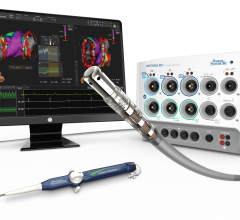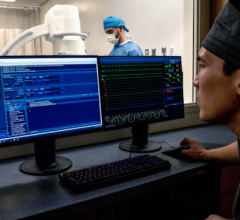July 19, 2011 — An article published in the July issue of the Journal of Heart and Lung Transplantation reports the first use of the Freedom portable driver with a Total Artificial Heart (TAH-t) patient. The TAH-t is manufactured by SynCardia Systems Inc.
July 19, 2011 - The Society of Cardiovascular Computed Tomography (SCCT) announces the first SCCT Arthur S. Agatston Cardiovascular Disease Prevention Award, recognizing individuals whose pioneering efforts have saved lives from coronary artery disease (CAD). Arthur Agatston, M.D., presented the award to the first recipients at the SCCT annual scientific meeting in Denver, Colo., on Saturday, July 16, 2011.
July 18, 2011 — NSVascular Inc., a newly formed subsidiary of NeuroSigma Inc., has signed an exclusive license with the University of California Los Angeles (UCLA) covering its medical applications of thin-film nitinol (TFN) technology.
Providing exceptional cardiovascular care for patients to achieve the best possible outcomes is the number one goal for ...
July 18, 2011 — OrbusNeich announced that data from an ex vivo arteriovenous (AV) shunt model of human circulating blood, in addition to results from three preclinical studies, demonstrated that the Genous Stent effectively captures circulating CD34+ endothelial progenitor cells (EPCs). This leads to accelerated re-endothelialization and decreased thrombogenicity compared to bare metal stents (BMS). These mechanistic data were published as an e-publication on the European Heart Journal website.
July 18, 2011 — An article published in the European Journal of Cardio-Thoracic Surgery demonstrates the importance of a comprehensive epicardial lesion pattern to confirm conduction block in radiofrequency ablation for the successful treatment of persistent atrial fibrillation (AF). The epicardial ablation device is manufactured by nContact Inc.

Coronary revascularization does not always lead to coronary reperfusion. When readily available, percutaneous coronary intervention (PCI) using primary balloon angioplasty, with or without use of stenting, is the standard of care for ST-segment elevation myocardial infarction (STEMI). However, there is a group of patients who seem not to benefit fully from prompt restoration of antegrade flow, as they fail to show resolution of the indirect signs of ischemia such as electrocardiographic (ECG) changes and improvements in perfusion abnormalities.[1,2] These patients also present an angiographic phenomenon characterized by evidence of slow-flow in the affected vessel (Thrombolysis in Myocardial Infarction [TIMI] flow equal to or less than 2) and lack of contrast uptake “blush” by the subtended myocardium, leading to a potential dissociation between coronary revascularization and myocardial perfusion in STEMI.
Cardiac positron emission tomography (PET) is growing in popularity among cardiologists because it provides the ability ...
Digging through boxes, waiting for couriers, finding smashed VHS tapes in the mail, jockeying back and forth between multiple modalities. Like at other hospitals across the country, the manual, tape- and film-based workflow in the pediatric cardiology department at Mercy Children’s Hospital in Toledo, Ohio, had stagnated, quadrupling the time it should have taken the cardiologists to read echocardiograms for the hospital and four outreach centers, resulting in a report turnaround time that could be as long as five to seven days.
Swedish SCAAR Registry data were presented in May during the EuroPCR meeting in Paris. The 30-day ST-elevated myocardial infarction (STEMI) mortality was 4.4% in the femoral access group vs. 3.2% in the radial access group (adjusted odds ratio 0.57, p<0.01). The benefit of radial approach was present at one year as well (7.3% femoral vs. 6.2% radial mortality, adjusted OR 0.78, p=0.018).
A review of recent transradial study data.
When performing radiofrequency (RF) ablation to treat cardiac arrhythmia, medical professionals must balance the safety ...

Transradial catheterization is increasingly becoming the access site of choice for many hospitals throughout the United States. Completing the procedure through the arm offers greater satisfaction for the patient as a result of increased comfort and patient mobility compared to femoral artery access. Radial artery access for cardiac catheterization is associated with a different set of complications and although infrequent, they present a challenge to cath lab staff to manage and prevent these issues as they appear. Education about the benefits and challenges of transradial catheterization is an important tool to nurses and technologists as they transition to cardiac catheterization through the wrist. This article will discuss patient satisfaction of radial versus femoral artery access and two of the most prevalent complications of transradial catheterization.

In recent years, advanced visualization has also become more accessible and prevalent. What used to be a niche technology, available only on dedicated and expensive workstations, has become very common. The software is now included in most workstations and multi-site picture archiving and communications systems (PACS).

A drug-eluting, self-expanding stent that does not use a drug-carrier polymer is before the U.S. Food and Drug Administration (FDA) final pre-market approval (PMA) review and a decision is expected later this year. Its chances of approval appear very bright, considering its positive clinical trial data to date.
Change Healthcare Cardiology Hemodynamics is an integrated hemodynamic monitoring system for monitoring vital signs and ...

Navigating through the world of coronary stents is about to become more complex. A plethora of new products are on the horizon, which will utilize new platforms and alloys and present novel options in polymer technology. Whilst most of the new stents will upgrade the platform and polymer, the choice of drug is not changing in most cases. This new generation of drug-eluting stents (DES) promises increased deliverability and radial strength in the platform. New polymers will minimize the concerns around late stent thrombosis (LST) and the need for long-term dual antiplatelet therapy (DAPT). A bioresorbable drug-eluting scaffold also may be game changer in the treatment of coronary artery disease.

Catheter-based intra-cardiac echocardiography (ICE) is an imaging modality similar to intra-vascular ultrasound (IVUS). It allows imaging inside the heart to visualize cardiac structures and blood flow using Doppler imaging. The standard-of-care for this type of imaging is usually transesophageal echo (TEE), but ICE proponents say the intra-cardiac modality has several advantages.

Hypothermia for out-of-hospital and in hospital cardiac arrest has been demonstrated to have significant survival and neurologic benefits. While the data supporting its use in the cardiac cath lab is limited and the number of patients where this protocol would be potentially useful is small – STEMI patients surviving cardiac arrest with persistent comatose state after ROSC – the potential benefit to our patients is extremely high and in our opinion well worth the effort.


 July 19, 2011
July 19, 2011








